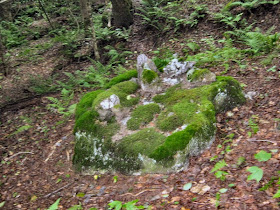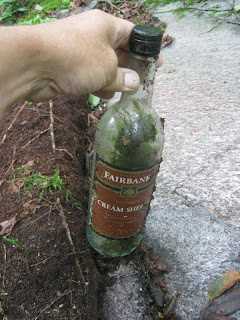Following a stream crossed by the Blue (Mattatuck) Trail in Watertown CT, I found boulders with some unusual stuff happening on them. The first I thought might be so old that the sandstone had fallen apart, but now I wonder - and will probably never really know - just what was going on here...
So then I look to the west:
A Split Rock with bridges??? And other "placed" stones????
And there's that sand again, all surrounded by thick moss...
...except where the moss is peeled, way over to the right of me:
I don't know what to think about this one...













Interesting. Especially with all that moss. Is this next to a brook with a lot of water in the air?
ReplyDeleteThis fascinating site should be studied by geologists and moss experts (there is a proper name for this, I know)to figure out just what is going on. Perhaps the kind of rock fosters exceptional moss growth. The mounds of moss remind me of the cairns on Glastonbury Mt. in Vermont that I wrote about. There the altitude, cloud cover and moisture undoubtedly contribute to the moss growth.
ReplyDeleteNorman
The sand is what gets me. There are stone rows and cobble stone piles on boulders here and there (I took photos but it was so dark under the pines that it was either use the flash or just get a blurry photo), but none with the sand or moss. My guess is that the sand rather than the rock supports the (super)growth. The alcohol supplies the reason perhaps for it and the "bridges' - and someone messing around with the stones on the boulders. Black Rock State Park website: "Tucked into the scenic rolling hills of the Western Highlands, 439-acre Black Rock offers a variety of outdoor activities. Steep, wooded ledges covered with pine, hemlock and oak provide the setting for Black Rock Pond.
ReplyDeleteBoth fact and legend account for the name "Black Rock." Early settlers to the Naugatuck Valley were given rights to mine graphite lead by the resident Indians around 1657. The description given the contrasting darker-colored rock material has persisted through the years.
Early use of the area by Native Americans has been confirmed by the arrowheads and stone implements. Artifacts unearthed at the park belonged to members of the Mohegan, Paugussett and Tunxis tribes.
Black Rock was given to the people of Connecticut in 1926 through the efforts of Black Rock Forest, Incorporated, a citizen's conservation group interested in woodland preservation. Development of access roads and facilities later became part of the Civilian Conservation Corps' economic recovery program."
Black Lichens used to cover the Rock, which is the real story about the Black Rock name.
BYTW: the nearby Clock Factory employed many German immigrants, including relatives of mine who transplanted many pines from the Black Forest to the area.
ReplyDelete